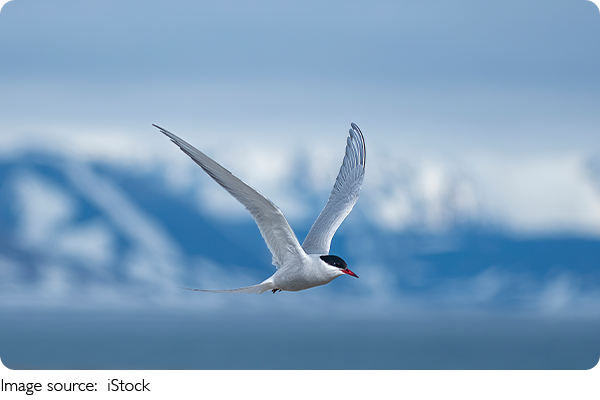Tern's Incredible Journey

The common tern (Sterna hirundo) is a remarkable bird species that belongs to the family Laridae. Known for its striking migratory patterns, the common tern is found in various regions, including the Arctic and surrounding areas.
This bird's breeding range spans across the northern hemisphere, particularly Europe, Asia, and North America. A true migratory species, it travels to tropical and subtropical seas for the winter.
Physical Characteristics
The common tern is a medium-sized bird, typically measuring between 34 and 37 centimeters in length, with a wingspan of 70 to 80 centimeters. Its slender and pointed red beak with a black tip, alongside long red legs, makes it quite distinctive. Although it is often confused with the Arctic tern (Sterna paradisaea) and the roseate tern (Sterna dougalli), there are clear differences in their appearance.
The common tern's back is not gray like the Arctic tern's; instead, it has a black wedge-shaped pattern. Its tail, when it stands, extends just to the wing tips, unlike the Arctic and roseate terns whose tails are longer.
Habitat and Behavior
During the winter months, the common tern’s head and underbelly turn white. Its calls are similar to that of the Arctic tern, but with a lower pitch and a less piercing tone. These birds are known for their aggressive nesting behavior, fiercely defending their territory from large intruders, even humans. The common tern typically nests along coastlines, islands, and suitable inland lakes, where they lay two to four eggs per breeding cycle.

Diet and Feeding Habits
The common tern's diet primarily consists of fish, which it catches by diving into the water—whether in the ocean, freshwater lakes, or large rivers. This feeding technique is similar to other terns in the Sterna genus but differs from the Arctic tern, which typically dives from a higher altitude. A fascinating courtship behavior involves the male offering fish to the female as a gesture of affection.
Migration and Lifespan
These terns are known for their extensive migratory journeys. In the winter, they migrate southwards to regions like South America, Africa, the Indian Ocean, Indonesia, and Australia, ensuring that they stay within warmer climates. The common tern’s lifespan can reach up to 23 years, with some individuals living even longer. This long lifespan is impressive considering the challenges of their migratory lifestyle.
Conservation Status and Protection
The common tern is listed as a species of least concern by the International Union for Conservation of Nature (IUCN). However, it is protected under various international agreements, including the African-Eurasian Migratory Waterbird Agreement (AEWA), which focuses on preserving migratory birds and their habitats. This protection ensures that the common tern continues to thrive across its wide-ranging habitat.
Fun Facts About the Common Tern
- The common tern is often confused with the Arctic tern and the roseate tern, but its unique features make it stand out.
- These birds are known to live for an impressive 23 years, which is quite long compared to many other seabirds.
- During migration, common terns can travel across vast distances, from the Arctic to tropical regions, making them one of the most impressive migratory birds.
on the Common Tern
As we dive deeper into the fascinating world of the common tern, we begin to truly appreciate its remarkable migratory journey and unique physical characteristics. These birds are not only significant for their ecological contributions, but also for their captivating behaviors and impressive lifespans. If you ever get the chance to see one of these terns in the wild, take a moment to admire their beauty and resilience. Their remarkable ability to navigate vast distances is a true marvel of nature.
Lykkers, have you ever seen a common tern in flight or observed its incredible migration firsthand? We’d love to hear your thoughts or any experiences you have had with these amazing birds! Share with us in the comments below!
The Arctic tern: A small bird that migrates big.
Video by James Wolfe
-
 Squid Defense Strategy!What makes squids so unstoppable in defense? Uncover their hidden tricks that leave predators stunned and wondering!
Squid Defense Strategy!What makes squids so unstoppable in defense? Uncover their hidden tricks that leave predators stunned and wondering! -
 What Are Polar Bears Hiding?Think You Know Polar Bears? Wait Until You See What Happens Behind the Ice!
What Are Polar Bears Hiding?Think You Know Polar Bears? Wait Until You See What Happens Behind the Ice! -
 Lion: Symbols of Strength!Want To Know Why Lions Are The Ultimate Symbols Of Strength? See What Makes Them Unstoppable!
Lion: Symbols of Strength!Want To Know Why Lions Are The Ultimate Symbols Of Strength? See What Makes Them Unstoppable!